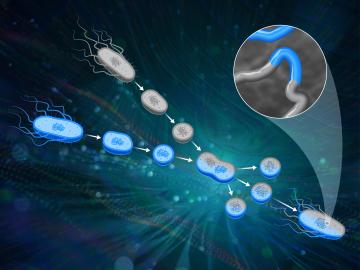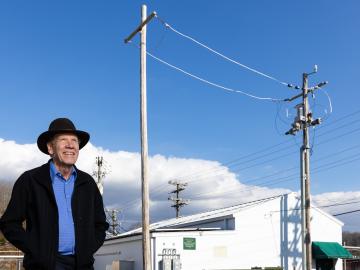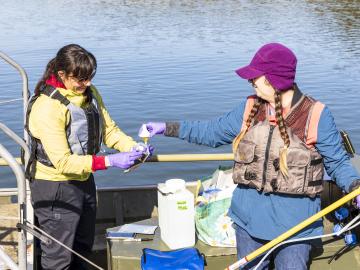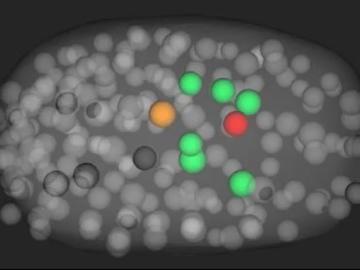
Filter News
Area of Research
- (-) Biology and Environment (40)
- (-) Computational Engineering (2)
- (-) Energy Science (67)
- Advanced Manufacturing (4)
- Biological Systems (1)
- Computational Biology (2)
- Computer Science (7)
- Electricity and Smart Grid (3)
- Fuel Cycle Science and Technology (1)
- Functional Materials for Energy (1)
- Fusion and Fission (30)
- Fusion Energy (11)
- Isotope Development and Production (1)
- Isotopes (12)
- Materials (58)
- Materials for Computing (7)
- National Security (25)
- Neutron Science (26)
- Nuclear Science and Technology (38)
- Nuclear Systems Modeling, Simulation and Validation (1)
- Quantum information Science (3)
- Sensors and Controls (1)
- Supercomputing (82)
News Topics
- (-) Biomedical (21)
- (-) Exascale Computing (6)
- (-) Frontier (5)
- (-) Grid (40)
- (-) Machine Learning (16)
- (-) Microscopy (15)
- (-) Nuclear Energy (7)
- (-) Space Exploration (3)
- 3-D Printing/Advanced Manufacturing (81)
- Advanced Reactors (6)
- Artificial Intelligence (16)
- Big Data (16)
- Bioenergy (66)
- Biology (80)
- Biotechnology (17)
- Buildings (38)
- Chemical Sciences (19)
- Clean Water (19)
- Composites (19)
- Computer Science (43)
- Coronavirus (22)
- Critical Materials (9)
- Cybersecurity (9)
- Energy Storage (72)
- Environment (138)
- Fossil Energy (2)
- Fusion (2)
- High-Performance Computing (24)
- Hydropower (10)
- Isotopes (2)
- Materials (39)
- Materials Science (29)
- Mathematics (6)
- Mercury (10)
- Microelectronics (1)
- Molten Salt (1)
- Nanotechnology (11)
- National Security (7)
- Neutron Science (15)
- Partnerships (13)
- Physics (2)
- Polymers (12)
- Quantum Science (2)
- Security (6)
- Simulation (18)
- Statistics (1)
- Summit (14)
- Transportation (67)
Media Contacts

ORNL scientists had a problem mapping the genomes of bacteria to better understand the origins of their physical traits and improve their function for bioenergy production.

Surrounded by the mountains of landlocked Tennessee, Oak Ridge National Laboratory’s Teri O’Meara is focused on understanding the future of the vitally important ecosystems lining the nation’s coasts.

ORNL and the Tennessee Valley Authority, or TVA, are joining forces to advance decarbonization technologies from discovery through deployment through a new memorandum of understanding, or MOU.

ORNL, TVA and TNECD were recognized by the Federal Laboratory Consortium for their impactful partnership that resulted in a record $2.3 billion investment by Ultium Cells, a General Motors and LG Energy Solution joint venture, to build a battery cell manufacturing plant in Spring Hill, Tennessee.

Bruce Warmack has been fascinated by science since his mother finally let him have a chemistry set at the age of nine. He’d been pestering her for one since he was six.

Researchers at Oak Ridge National Laboratory are using a novel approach in determining environmental impacts to aquatic species near hydropower facilities, potentially leading to smarter facility designs that can support electrical grid reliability.

Scientists have developed a novel approach to computationally infer previously undetected behaviors within complex biological environments by analyzing live, time-lapsed images that show the positioning of embryonic cells in C. elegans, or roundworms. Their published methods could be used to reveal hidden biological activity.

A team of scientists led by the Department of Energy’s Oak Ridge National Laboratory and the Georgia Institute of Technology is using supercomputing and revolutionary deep learning tools to predict the structures and roles of thousands of proteins with unknown functions.

Ten scientists from the Department of Energy’s Oak Ridge National Laboratory are among the world’s most highly cited researchers, according to a bibliometric analysis conducted by the scientific publication analytics firm Clarivate.

A team including researchers from the Department of Energy’s Oak Ridge National Laboratory has developed a digital tool to better monitor a condition known as Barrett’s esophagus, which affects more than 3 million people in the United States.


